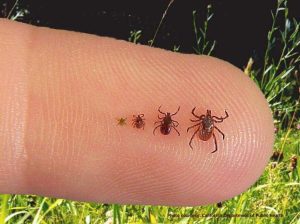Lyme disease, a tick-borne illness caused by the bacteria Borrelia burgdorferi, has been on the rise in recent years. In 2023, the number of cases increased significantly, leading experts to label it as an epidemic. It’s essential to be well-informed about the symptoms, long-term effects, and preventive measures to protect yourself and your loved ones.
And remember, you can catch Lyme disease in the winter! Contrary to popular belief, ticks don’t hibernate during the colder months. They’re just waiting for a warm day to come out and find their next meal. So, if you’re planning a winter hike, don’t forget to wear long pants tucked into your socks and use insect repellent.

Symptoms at the Time
In the early stages of Lyme disease, many individuals experience flu-like symptoms such as fever, chills, fatigue, and headaches. A unique characteristic of Lyme disease is the appearance of a bull’s-eye rash, also known as an erythema migrans, which expands around the site of the tick bite. If left untreated, the infection can spread to the joints, heart, and nervous system, causing more severe symptoms.
Symptoms Years Later
Long-term effects of Lyme disease can be debilitating and may include chronic joint pain, cognitive difficulties, and heart problems. Some individuals may experience post-treatment Lyme disease syndrome (PTLDS), which can cause persistent symptoms even after antibiotic treatment. Early detection and treatment are crucial to prevent long-term complications.
Treatment Options
Antibiotics are the primary treatment for Lyme disease, and early diagnosis and treatment can significantly improve the outcome. Common antibiotics prescribed include doxycycline, amoxicillin, and cefuroxime. In some cases, intravenous antibiotics may be necessary for more severe infections. It’s essential to consult with a healthcare professional to determine the most appropriate treatment plan for your specific situation.
Prevention and Avoidance
To minimize the risk of contracting Lyme disease, follow these preventive measures:
- Wear protective clothing when in wooded or grassy areas, such as long-sleeved shirts and pants tucked into socks.
- Use insect repellent containing DEET or permethrin on clothing and exposed skin.
- Regularly check for ticks on your body and clothing after spending time outdoors, and promptly remove any ticks using a pair of fine-tipped tweezers, or better still scrape off (away) with a credit card taking care not to squeeze blood back into the victim. Covering in Vaseline can also lead the tick to withdraw from the body.
- Keep your lawn and outdoor areas well-maintained, as ticks prefer tall grass and brush.
- Shower and wash your clothes after spending time in tick-infested areas.
The Lyme disease epidemic is a growing concern, and being well-informed about the symptoms, treatment options, and preventive measures is crucial. By staying vigilant and taking the necessary precautions, you can protect yourself and your family from this debilitating illness. Remember to consult with a healthcare professional if you suspect you have Lyme disease or have been bitten by a tick. Together, we can work towards reducing the impact of this epidemic.

